This is a brief introduction to the Travel Trailer type of RV, intended to provide essential information for choosing the best RV type. (Looking for Travel Trailer Manufacturers?)
Not sure if this is the right RV type for you? Please take a look at our RV Types Pros & Cons Checklist.
What Is a Travel Trailer RV?
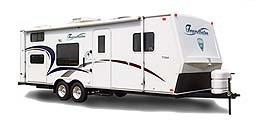
Definition of a Travel Trailer
A travel trailer is a recreational vehicle (RV) built on a trailer chassis where the frame is coupled to the tow vehicle using a hitch coupler. It’s also commonly called a conventional trailer, camper trailer, bumper pull trailer, or tagalong trailer.
99% of travel trailers use a ball coupler to connect to the tow vehicle. Off-road models may use a pintle hitch or multi-axis articulating hitch.
Travel trailer chassis frames have tongues, usually of the A-frame design. The tongue extends past the camper body about four feet. This places about 10 to 15% of the trailer’s weight (called the tongue weight) on the hitch point.
Unlike motorhome RVs like Class B’s and Class C’s, you tow a travel trailer using a tow vehicle. You don’t drive one. And no, you don’t generally need a special license to tow one!
Travel Trailer RV Specifications
Dimensions
- Lengths range from 12 to 41 feet, with 22 to 36 feet being the most common.
- Width ranges from 6 ft 8 inches (narrow) to 8.5 ft (wide-body). Between 7 and 8 feet is most common.
- Height varies from 9 to 13.5 feet, with most ranging between 10 and 12.5 feet (A/C included).
Please note this article does not consider separate “travel trailer” genres like teardrops, canned hams, micro campers, etc.
Driving an RV for the first time? Check out our guide to what you need to know about length, width, height, and weight!
Sleeping Capacity
Most Travel trailer RVs can fit 4-12 sleepers (6-8 standard). That doesn’t mean there’s room for 4-12 to sit down at once, though!
Travel Trailer Categories
Travel trailers boast the most diversity of any RV genre. You can purchase bunkhouse models, toy haulers, mega-sized teardrops, vintage dropfloor models, fiberglass models, etc. It’s difficult to break them down into separate categories.
Many of these sub-genres are written about separately. Please see our articles about teardrops, toy haulers, and fiberglass campers.
At their essence, travel trailers are boxes on wheels. They are supposed to make you feel at home. Walk inside, and you’ll see dinettes, bunk beds, TVs, kitchen counter tops – everything you just left at the house.
Travel trailers are also built using a dizzying amount of construction techniques. You can read more about sidewall construction techniques from AskTheRVengineer.com. You may see travel trailers distinguished by construction technique, aka a stick n’ tin versus a laminate fiberglass unit.
Travel trailers may also be distinguished by design package:
- Ultralight: Usually built with weight-saving techniques such as aluminum framework, lightweight plywood, or composite panels.
- 4-Season: Built with additional insulation and/or heating elements for 3-1/2 (rarely true 4-season) winter and cold weather camping.
- Vintage: Inspired by classic campers from the ’50s and ’60s, vintage campers may be built under resurrected brand names such as Scotty or Shasta.
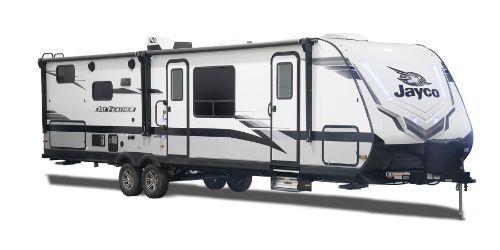
Travel Trailer RV Description
Travel trailers arrived hot on the heels of mass manufacturing. RVs were sold in America as early as 1910, just a few years after the debut of the historic Ford Model T.
And in one sense, they really haven’t changed since. Sure, the technology is leaps and bounds ahead, but the idea is the same: A travel trailer is essentially a second, smaller house. So you don’t have to “camp” to go camping.
Travel trailers come in all sizes, from 3,000 to 20,000 lbs! The smallest travel trailers are nothing more than a dinette, a kitchenette and a portable toilet, all squeeze into a space not much bigger than your walk-in closet. Others are almost 300 square feet, bigger than a Tiny House, and come with a free butler.
Competition is fierce in this industry. The lowest tier of travel trailers suffers from slap-dash quality and nickel-and-dime components. The highest tier of travel trailers, such as Airstream and Living Vehicle, cost more than your house (and they’re probably nicer).
Class A RV Chassis & Fuel Economy
These RVs typically look like big, narrow boxes with a rounded or sloped front end. They are built on chassis frames either fabricated in-house or sourced from major OEM manufacturers. Big names include:
- Norco
- Lippert
More than any other RV type, travel trailers are likely to be built on chassis frames either designed and fabricated by the RV manufacturer or outsourced to a regional metal fabrication shop. So pay close attention!
But like most RVs, the RV manufacturer doesn’t usually build the appliances or major parts within the camper (Winnebago and Airstream are major exceptions). The manufacturer typically sources the major components and constructs their own floorplan and layout. So think of the RV manufacturer more as the final assembler.
Fuel economy of your tow vehicle is primarily affected by the frontal area and relative weight of the travel trailer. So a heavy, tall and wide travel trailer will have a greater impact on your gas mileage than a lightweight, short and narrow camper.
Typically, larger and more powerful vehicles, such as diesel three-quarter-ton trucks, see a much smaller decrease in fuel efficiency compared to gas-powered passenger vehicles.
Who Might Want a Travel Trailer?
Phrased another way: Who doesn’t want a travel trailer?
Travel trailers have a lot going for them.
- They can be towed by many types of vehicles, from SUVs to trucks.
- They can be used seasonally or full-time.
- They can be purchased for $20,000, $100,000 or $500,000!
- They can be stored over the winter.
- They look and feel like a small house.
- You don’t have to worry about damaging a $20,000 engine or drivetrain.
This is why more than one out of every three RV is a travel trailer!
However, they do have some compromises.
- Unlike a motorhome, you can’t occupy a travel trailer while in transit.
- They don’t offer as much floorspace or headroom as a 5th wheel.
- Travel trailers typically have limited cargo carrying capacity (CCC).
- They are the most difficult and squirrely to tow of any RV type.
- Often, to tow a $50,000 conventional trailer, you need a $50,000 truck!
Travel Trailer RV Pros and Cons
PROS
- Spacious, open floor plans suitable for a variety of uses, including snowbirding.
- Provides more interior space per length foot than motor homes because it does not contain driving and engine compartments.
- Tow vehicle doubles as local transportation.
- Lower profile allows easier entry than a fifth wheel trailer.
- Lower profile allows roof storage of items such as canoes, with less concern for top clearance.
- Can be towed with a variety of vehicles fitted with a standard ball hitch and rated for the trailer weight.
CONS
- Least stable on the road of all RV types. Requires the most skill to tow and back up.
- Large trailers require large trucks.
- Less storage than fifth wheel trailers because it lacks a raised section.
- Driving and living compartments are separate. Living area inaccessible while moving.
- Generally cannot tow vehicle behind trailer.
- Larger models can be difficult to maneuver in tight spaces.
- Larger models require large storage area when not in use.
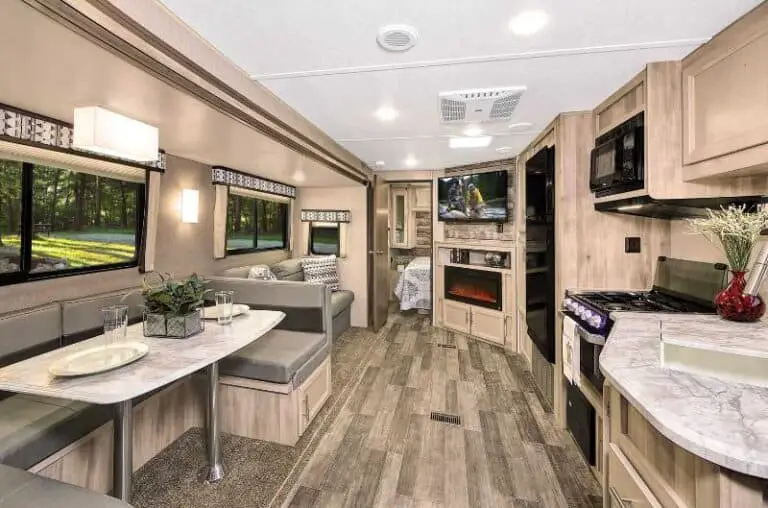
Key Features in a Conventional Trailer
Layout Is Everything!
There’s a saying in the RV industry that goes something like this: “Colors and patterns sell campers.” I’d expand that to include layouts and floorplans.
Travel trailers are sold in a dizzying variety of floorplans. You can get multiple master bedrooms, multiple bathrooms, double bunk beds, murphy beds, 2-person or 4-person dinettes, U-shaped kitchens, single-wall kitchens, shower or a bathtub … the list goes on!
Many travel trailers have one or two slide-outs, like this Jayco Jayflight SLX 8 265RLS. Check out all that leg room! It can be used with the slide-outs deployed or within.
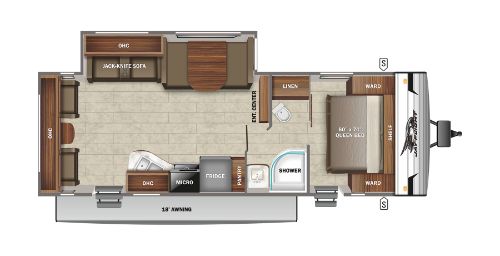
However, some are hard-sided and don’t have any slide-outs, which sacrifices space, but can help you avoid maintenance headaches. For an example, check out this Airstream International 25FB. While much smaller, does it really lose any critical features?
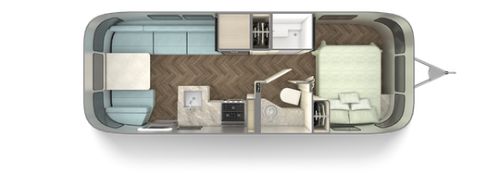
Here are some questions to help you choose a layout that will work best (and hopefully age with) your family’s needs.
Sleeping
- What size of bed (twin, full, queen, short queen, king) do I need?
- Am I going to sleep in the same bed as my partner, or will we need dual twin beds?
- Can we scoot to the end of a bed, or do we need to roll off the side?
- How much visual or acoustic privacy do we need? Will a curtain suffice, or a solid wall and a door?
- Do we need a TV in our bedroom?
- Do we need an adjacent master bath?
- Do we need a full-size bed for kids or guests, or will a murphy, sofa or bunk bed do the trick?
Seating
- Where will we eat breakfast, lunch and dinner? Do we need a breakfast nook in addition to the main living area?
- Do we need a separate table for office space?
- How many people need to be able to watch TV or eat a meal at once?
Where Will You Store Stuff?
- Does the RV offer exterior pass-through storage?
- Can you mount a roof rack on top of the RV?
- Are there any hide-a-beds, futons or convertible dinettes?
- Is there sufficient kitchen cabinet space?
- What’s the weight rating on the bumper hitch?
- Is there room to mount anything on the trailer tongue A-frame?
How Much Cargo Carrying Capacity?
It is not uncommon for travel trailers of any size, style or construction to offer less than 2,000 pounds of cargo carrying capacity! And some offer less than 1,000 pounds!
Don’t buy a travel trailer based on the floorplan. Pay attention to the GVWR and Cargo Carrying Capacity first. If the trailer doesn’t offer at least 2,000 pounds of CCC, carefully consider your decision. You want some space for your bikes, camping gear and firewood!
Travel Trailer Sub-Types
Travel trailers have so many sub-types and categories that they all blend together!
1. Conventional Trailer
While the categories below aren’t formal types, they help to separate the myriads of lookalike trailers at your dealership’s lot.
Ultralight/Single-Axle
Single-axle campers can usually only carry up to 5,200 lbs GAWR. These campers are usually sold as ultra-lightweight campers for people who are towing with a common passenger vehicle.
Our advice: Check the tongue weight! RV salesmen like to sell based off gross weight, but usually, it’s the tongue weight restriction that limits smaller vehicles.
Off-Road
“Off-road” travel trailers may have upgraded torsion axle or independent suspensions plus lift blocks.
Very few manufactures will officially designate their trailers as off-road models. Too much liability. So don’t assume that just because you have studded mud tires that the manufacturer planned on you running the local Jeep trails.
If the manufacturer does advertise 4×4 capabilities, ask what testing has been done to confirm the rating.
4-Season
Don’t assume a “4-season” package really equips your camper for all seasons! The quality of a 4-season options package varies widely by manufacturer.
Ask if the camper can be used in sub-freezing temperatures without winterizing the water lines. Ask if the camper has been tested and used in sub-freezing conditions.
2. Destination Trailer
A destination trailer is a travel trailer (flat tow) optimized and designed for seasonal or year-long campground living. They are huge, heavy, boxy and extremely spacious – not something you want to be towing around every weekend! Most need to be towed with a one-ton or medium-duty truck.
Destination trailers are generally used by snowbirds who relocate with the seasons.
Here is a floorplan from the 2022 Crossroads Hampton HP388FKL destination trailer:
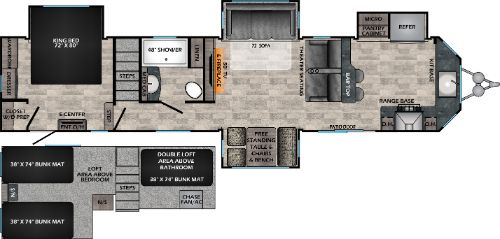
Think of a destination trailer as a cheaper version of a full-time 5th wheel. Since they are designed to be moved maybe once or twice a year, they don’t have the complicated auto-leveling systems and other features of a typical mobile travel trailer. The money saved from the chassis goes into the interior furnishings.
Some of the floorplans boast second-story lofts and half-wall living room slide-outs. They have residential accents like bay windows, electric fireplaces, center kitchen island, a washer and dryer, etc.
Destination trailers are commonly confused with Park Model RVs (PMRVs). Both are designed for full-time campground living.
However, park models aren’t self-contained; they don’t have built-in tanks for off-grid living. They are built to a different construction code: ANSI A119.5 Park Model Recreational Vehicle Standard.
Park model RVs may be wider than 102″ (8.5 feet) and can only be moved with a permit, usually by a professional service. Please read our guide to Park Model RVs for more information.
Travel Trailer Major Manufacturers
There are about 42 major travel trailer RV manufacturers in North America.
Some of the biggest names include:
- Forest River
- Keystone
- Jayco
- Heartland
- Coachman
- Airstream
For a full list of manufacturers, check out our comprehensive RV manufacturer’s list!
There are also dozens of custom coachbuilders who will design you a bespoke travel trailer, complete with cat towers, double queen beds, pop-up roofs, or whatever else your heart desires. They are not shown on our lists.
We’ve spotlighted a few brands below. These brands are either known for their popularity, quality, or innovation.
Northwood Manufacturing

Northwood Manufacturing is an RV manufacturer based in the state of Oregon and has been in operation since 1998. The company is owned by Northwood Investments.
One of the largest private ownership or family-owned RV manufacturers, Northwood Mfg is known for its commitment to construction quality, attention to detail, and true 4-season design. Their travel trailer series include Arctic Fox and Nash.
Coachman

Coachmen is an RV manufacturer based in the state of Indiana and has been in operation since 1964. The company is owned by Berkshire Hathaway.
One of the monster RV brands, Coachman builds just about everything. Quality runs the gamut from excellent to mediocre.
The company is most well-known for its conventional trailers and roomy floorplans.
Keystone RV
![]()
Keystone RV is an RV manufacturer based in the state of Indiana and has been in operation since 1996. The company is owned by Thor Industries.
Keystone RV is a mainstream RV manufacturer based in Indiana who builds many familiar Big Box brands of travel trailers, fifth wheels and toy haulers. Their Springdale series is the archetypical American stick n’ tin trailer.
Jayco

Jayco is an RV manufacturer based in the state of Indiana and has been in operation since 1968. The company is owned by Thor Industries.
Airstream

Airstream is an RV manufacturer based in the state of Ohio and has been in operation since 1931. The company is owned by Thor Industries.
The iconic RV brand! – and one of the few that holds its value over time. Airstream campers feature plush furnishings, modern design, and an aircraft-inspired riveted aluminum monocoque structure. Choose from eight model series, from the tiny Bambi or Caraval to the office-on-wheels Flying Cloud to the 28-ft Pottery Barn Special edition.
Travel Trailer FAQs
Yes!
In fact, travel trailers are good for most types of camping.
With sufficient clearance, travel trailers can access out-of-the-way locations. Just remember to bring a spare tire when primitive camping!
And most have enough room for spare batteries or a generator.
Travel trailers are also good for basecamping, since you don’t need to tow a second vehicle. Just use your tow vehicle as a daily driver!
Where travel trailers fall short is urban camping. They are difficult (even impossible) to maneuver down city streets.
No. Generally, you cannot “triple-tow” with a travel trailer. Even states that allow triple-towing generally do not allow it with a camper trailer because of maximum motorcade length and weight restrictions.
However, you can just use your tow vehicle as your daily driver!
Most travel trailers must be towed with a half-ton pickup, large SUV, or flatbed truck or larger. Smaller units can be towed with passenger SUVs and CUVs. Most travel trailers top out at 10,000 GVWR and would tow best with a medium-duty truck.
To help you answer this question, please took a look at these two resources:
Related RV Checklists
The following RV checklists on our website are applicable to travel trailers:






